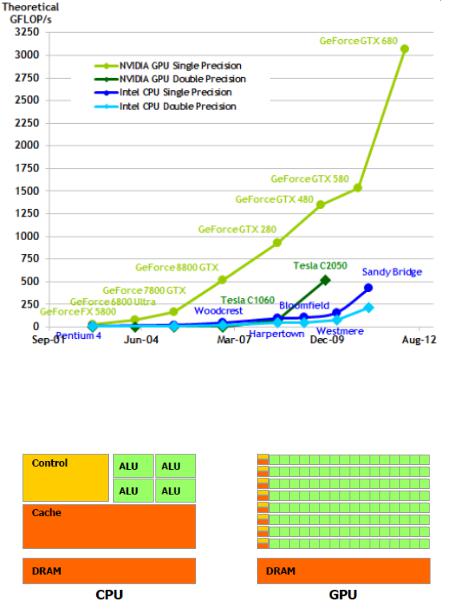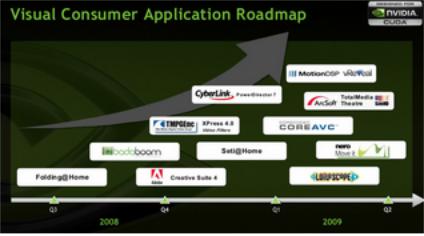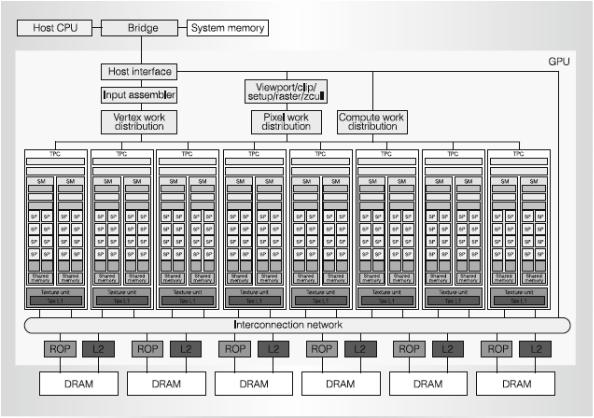
Image Processing with CUDA
.pdfChapter 1
Introduction
Graphics cards are widely used to accelerate gaming and 3D graphics applications. The GPU (Graphics Processing Unit) of a graphics card is built for compute-intensive and highly parallel computations. With the prevalence of high level APIs (CUDA - Compute Uni ed Device Architecture), the power of the GPU is being leveraged to accelerate more general purpose and high performance applications. It has been used in accelerating database operations[1], solving di erential equations[2], and geometric computations[3].
Image processing is a well known and established research eld. It is a form of signals processing in which the input is an image, and the output can be an image or anything else that undergoes some meaningful processing. Altering an image to be brighter, or darker is an example of a common image processing tool that is available in basic image editors.
Often, processing happens on the entire image, and the same steps are applied to every pixel of the image. This means a lot of repetition of the same work. Newer technology allows better quality images to be taken. This equates to bigger les and longer processing time. With the advancement of CUDA, programming to the GPU is simpli ed. The technology is ready to be used as a problem solving tool in the eld of image processing.
This thesis shows the vast performance gain of using CUDA for image processing. Chapter
1
two gives an overview of the GPU, and gets into the depths of CUDA, its architecture and its programming model. Chapter three consists of the experimental section of this thesis. It provides both the sequential and parallel implementations of two common image processing techniques: image blurring and edge detection. Chapter four shows the experiment results and the thesis is concluded in chapter ve.
2
Chapter 2
CUDA
CUDA (Compute Uni ed Device Architecture) is a parallel computing architecture developed by NVidia for massively parallel high-performance computing. It is the compute engine in the GPU and is accessible by developers through standard programming languages. CUDA technology is proprietary to NVidia video cards.
NVidia provides APIs in their CUDA SDK to give a level of hardware extraction that hides the GPU hardware from developers. Developers no longer have to understand the complexities behind the GPU. All the intricacies of instruction optimizations, thread and memory management are handled by the API. One bene t of the hardware abstraction is that this allows NVidia to change the GPU architecture in the future without requiring the developers to learn a new set of instructions.
2.1GPU Computing and GPGPU
The Graphics Processing Unit (GPU) is a processor on a graphics card specialized for computeintensive, highly parallel computation. it is primarily designed for transforming, rendering and accelerating graphics. It has millions of transistors, much more than the Central Processing Unit
3
(CPU), specializing in oating point arithemetic. Floating point arithemetic is what graphics rendering is all about. The GPU has evolved into a highly parallel, multithreaded processor with exceptional computational power. The GPU, since its inception in 1999, has been a dominant technology in accelerated gaming and 3D graphics application.
The main di erence between a CPU and a GPU is that a CPU is a serial processor while the GPU is a stream processor. A serial processor, based on the Von Neumann architecture executes instructions sequentially. Each instruction is fetched and executed by the CPU one at a time. A stream processor on the other hand executes a function (kernel) on a set of input data (stream) simultaneously. The input elements are passed into the kernel and processed independently without dependencies among other elements. This allows the program to be executed in a parallel fashion.
Due to their highly parallel nature, GPUs are outperforming CPUs by an astonishing rate onoating point calculations (Figure 2.1)[4]. The main reason for the performance di erence lies in the design philosophies between the two types of processors (Figure 2.2)[4]. The CPU is optimized for high performance on sequential operations. It makes use of sophisticated control logic to manage the execution of many threads while maintaining the appearance of a sequential execution. The large cache memories used to reduce access latency and slow memory bandwidth also contribute to the performance gap.
4

Figure 2.1: GPU vs CPU on oating point calculations
Figure 2.2: CPU and GPU chip design
The design philosophy for GPUs on the other hand is driven by the fast growing video game industry that demands the ability to perform massive oating-point calculations in advanced video games. The motivation is to optimize the execution of massive number of threads, minimize control logic, and have small memory caches so that more chip area can be dedicated to oating-point
5
calculations. This trade-o makes the GPU less e cient at sequential tasks designed for the CPU. Recognizing the huge potential performance gains, developers hungry for high performance began using the GPU for non graphics purposes. Improvements in the programmability of graphics hardware further drove GPU programming. Using high-level shading languages such as DirectX, OpenGL and Cg, various data parallel algorithms can be mapped onto the graphics API. A traditional graphics shader is hardwired to only do graphical operations, but now it is used in everyday general-purpose computing. Researchers have discovered that the GPU can accelerate certain problems by over an order of magnitude over the CPU. Using the GPU for general purpose computing
creates a phenomenon known as GPGPU.
GPGPU is already being used to accelerate applications over a wide range of cross-disciplinaryelds. Many applications that process large data sets take advantage of the parallel programming model by mapping its data elements to parallel processing threads. Purcell and Carr illustrates how this mapping is done for ray-tracing[5][6]. Similarly, this concept can be applied to other elds. The GPU is also being adopted in accelerating database operations[1][7][8][9][10][11]. Work has been done using the GPU for geometric computations[3][12][13][14], linear algebra[15], solving partial di erential equations[2][16] and solving matrices[17][18]. As the GPU's oating-point processing performance continues to outpace the CPU, more data parallel applications are expected to be done on the GPU.
While the GPGPU model has its advantages, programmers initially faced many challenges in porting algorithms from the CPU over to the GPU. Because the GPU was originally driven and designed for graphics processing and video games, the programming environment was tightly constrained. The programmer requires a deep understanding of the graphics API and GPU architecture. These APIs severely limit the kind of applications that can be written on this platform. Expressing algorithms in terms of vertex coordinates and shader programs increased programming complexity. As a result, the learning curve is steep and GPGPU programming is not widespread.
Higher-level language constructs are built to abstract the details of shader languages. The Brook
6
Speci cations is created in 2003 by Stanford as an extension of the C language to e ciently incorporate ideas of parallel computing into a familiar language[19]. In 2006 a plethora of platforms including Microsoft's Accelerator[20], the RapidMind Multi-Core Development Platform[21] and the
PeakStream Platform[22] emerge. RapidMind is later acquired by Intel in 2009 and Peakstream is acquired by Google in 2007. By 2008 Apple released OpenCL[23], and AMD released its Stream Computing software deveopment kit (SDK) that is built on top of the Brook Speci cations. Microsoft released DirectCompute as part of its DirectX 11 package. NVidia released its Compute Uni ed Device Architecture (CUDA) as part of its parallel computing architecture. Popular commercial vendors such as Adobe and Wolfram are releasing cuda-enabled versions of their products (Figure 2.3)[24].
It is important to note that GPU processing is not meant to replace CPU processing. There are simply algorithms that run more e icently on the CPU than on the GPU. Not everything can be executed in a parallel manner. GPUs, however, o er an e cient alternative for certain types of problems. The prime candidates for GPU parallel processing are algorithms that have components that require a repeated execution of the same calculations, and those components must be able to be executed independently of each other. Chapter 3 explores image processing algorithms that t this paradigm well.
7

Figure 2.3: Products supporting CUDA
2.2CUDA architecture
A typical CUDA architecture consists of the components as illustrated in Figure 2.4[25]. The Host CPU, Bridge and System memory are external to the graphics card, and are collectively referred to as the host. All remaining components forms the GPU and the CUDA architecture, and are collectively referred to as the device. The host interface unit is responsible for communication such as responding to commands, and facilitating data transfer between the host and the device.
8

Figure 2.4: GPU Architecture. TPC: Texture/processor cluster; SM: Streaming Multiprocessor; SP: Streaming Processor
The input assembler collects geometric primitives and outputs a stream to the work distributors[25]. The work distributors forward the stream in a round robin fashion to the Streaming Processor Array (SPA). The SPA is where all the computation takes place. The SPA is an array of Texture/Processor Clusters (TPC) as shown in Figure 2.4[25]. Each TPC contains a geometry controller, a Streaming Multiprocessor (SM) controller (SMC), a texture unit and 2 SMs. The texture unit is used by the SM as a third execution unit and the SMC is used by the SM to implement external memory load, store and atomic access. A SM is a multiprocessor that executes vertex, geometry and other shader programs as well as parallel computing programs. Each SM contains 8 Streaming Processors (SP), and 2 Special Function Units (SFU) specializing in oating point functions such as square root and
9

transcendental functions and for attribute interpolations. It also contains an instruction cache, a constant cache, a multithreaded instruction fetch and issue unit (MT) and shared memory (Figure 2.5)[25]. Shared memory holds shared data between the SPs for parallel thread communication and cooperation. Each SP contains its own MAD and MUL units while sharing the 2 SFU with the other SPs.
Figure 2.5: Streaming Multiprocessor
A SM can execute up to 8 thread blocks, one for each SP. It is capable of e ciently executing hundreds of threads in parallel with zero scheduling overhead. The SMs employ the Single-Instruction, Multiple-Thread (SIMT) architecture to manage hundreds of concurrent threads[26]. GTX-200 series is equipped with 16 KB of shared memory per SM. In the GeForce 8-series GPU, each SP can handle up to 96 concurrent threads for a total of 768 threads per SM[27]. On a GPU with 16 SMs, up to 12,288 concurrent threads can be supported.
10
